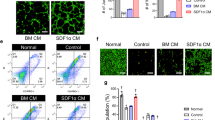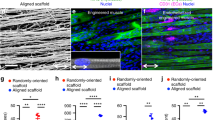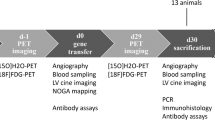Abstract
Vascular endothelial growth factor A (VEGF-A) induces strong angiogenesis and it has been widely used in proangiogenic gene therapy studies. However, little is known about long-term effects of VEGF-A expression in skeletal muscle. Here the long- term effects of adeno-associated virus (AAV) encoding human VEGF-A165 (AAV-VEGF-A) gene transfer in normal and ischemic rabbit hindlimb skeletal muscles were studied. AAV-LacZ was used as a control. In one-year follow-up, a remarkable increase in skeletal muscle perfusion compared with AAV-LacZ was observed measured with Doppler and contrast pulse sequence ultrasound. Angiogenesis was also seen in histology as enlarged and sprouting capillaries. In addition to favorable angiogenic effects, aberrant vascular structures with CD31 positive cell layers were seen inside muscle fibers after AAV-VEGF-A gene transfer. Importantly, we found increased amounts of extracellular matrix with a high number of macrophages and fibrosis in AAV-VEGF-A transduced muscles. No changes in skeletal muscle morphology were detected in AAV-LacZ transduced muscles. Our results indicate that local AAV-VEGF-A gene transfer efficiently promotes long-term angiogenesis in large animal model. However, non-regulated expression of VEGF-A causes unfavorable changes in muscle morphology, which suggests the need for regulation of the transgene expression in long-term AAV-mediated VEGF-A gene transfer applications.
This is a preview of subscription content, access via your institution
Access options
Subscribe to this journal
Receive 12 print issues and online access
$259.00 per year
only $21.58 per issue
Buy this article
- Purchase on Springer Link
- Instant access to full article PDF
Prices may be subject to local taxes which are calculated during checkout





Similar content being viewed by others
Change history
08 December 2011
This article has been corrected since Advance Online Publication and a corrigendum is also printed in this issue
References
Rissanen TT, Yla-Herttuala S . Current status of cardiovascular gene therapy. Mol Ther 2007; 15: 1233–1247.
Karvinen H, Yla-Herttuala S . New aspects in vascular gene therapy. Curr Opin Pharmacol 2010; 10: 208–211.
Rissanen TT, Korpisalo P, Markkanen JE, Liimatainen T, Orden MR, Kholova I et al. Blood flow remodels growing vasculature during vascular endothelial growth factor gene therapy and determines between capillary arterialization and sprouting angiogenesis. Circulation 2005; 112: 3937–3946.
Rajagopalan S, Mohler III ER, Lederman RJ, Mendelsohn FO, Saucedo JF, Goldman CK et al. Regional angiogenesis with vascular endothelial growth factor in peripheral arterial disease: a phase II randomized, double-blind, controlled study of adenoviral delivery of vascular endothelial growth factor 121 in patients with disabling intermittent claudication. Circulation 2003; 108: 1933–1938.
Makinen K, Manninen H, Hedman M, Matsi P, Mussalo H, Alhava E et al. Increased vascularity detected by digital subtraction Angiography after VEGF gene transfer to human lower limb artery: a randomized, placebo-controlled, double-blinded phase II study. Mol Ther 2002; 6: 127–133.
Nikol S, Baumgartner I, Van BE, Diehm C, Visona A, Capogrossi MC et al. Therapeutic angiogenesis with intramuscular NV1FGF improves amputation-free survival in patients with critical limb ischemia. Mol Ther 2008; 16: 972–978.
Wu Z, Asokan A, Samulski RJ . Adeno-associated virus serotypes: vector toolkit for human gene therapy. Mol Ther 2006; 14: 316–327.
Daya S, Berns KI . Gene therapy using adeno-associated virus vectors. Clin Microbiol Rev 2008; 21: 583–593.
Warrington Jr KH, Herzog RW . Treatment of human disease by adeno-associated viral gene transfer. Hum Genet 2006; 119: 571–603.
Niemeyer GP, Herzog RW, Mount J, Arruda VR, Tillson DM, Hathcock J et al. Long-term correction of inhibitor-prone hemophilia B dogs treated with liver-directed AAV2-mediated factor IX gene therapy. Blood 2009; 113: 797–806.
Stieger K, Schroeder J, Provost N, Mendes-Madeira A, Belbellaa B, Le MG et al. Detection of intact rAAV particles up to 6 years after successful gene transfer in the retina of dogs and primates. Mol Ther 2009; 17: 516–523.
Riviere C, Danos O, Douar AM . Long-term expression and repeated administration of AAV type 1, 2 and 5 vectors in skeletal muscle of immunocompetent adult mice. Gene Therapy 2006; 13: 1300–1308.
Shimpo M, Ikeda U, Maeda Y, Takahashi M, Miyashita H, Mizukami H et al. AAV-mediated VEGF gene transfer into skeletal muscle stimulates angiogenesis and improves blood flow in a rat hindlimb ischemia model. Cardiovasc Res 2002; 53: 993–1001.
Arsic N, Zacchigna S, Zentilin L, Ramirez-Correa G, Pattarini L, Salvi A et al. Vascular endothelial growth factor stimulates skeletal muscle regeneration in vivo. Mol Ther 2004; 10: 844–854.
Rissanen TT, Korpisalo P, Karvinen H, Liimatainen T, Laidinen S, Grohn OH et al. High-resolution ultrasound perfusion imaging of therapeutic angiogenesis. JACC Cardiovasc Imaging 2008; 1: 83–91.
Summerford C, Samulski RJ . Membrane-associated heparan sulfate proteoglycan is a receptor for adeno-associated virus type 2 virions. J Virol 1998; 72: 1438–1445.
Ferrara N, Henzel WJ . Pituitary follicular cells secrete a novel heparin-binding growth factor specific for vascular endothelial cells. Biochem Biophys Res Commun 1989; 161: 851–858.
Deodato B, Arsic N, Zentilin L, Galeano M, Santoro D, Torre V et al. Recombinant AAV vector encoding human VEGF165 enhances wound healing. Gene Therapy 2002; 9: 777–785.
Zacchigna S, Tasciotti E, Kusmic C, Arsic N, Sorace O, Marini C et al. In vivo imaging shows abnormal function of vascular endothelial growth factor-induced vasculature. Hum Gene Ther 2007; 18: 515–524.
Zacchigna S, Papa G, Antonini A, Novati F, Moimas S, Carrer A et al. Improved survival of ischemic cutaneous and musculocutaneous flaps after vascular endothelial growth factor gene transfer using adeno-associated virus vectors. Am J Pathol 2005; 167: 981–991.
Tafuro S, Ayuso E, Zacchigna S, Zentilin L, Moimas S, Dore F et al. Inducible adeno-associated virus vectors promote functional angiogenesis in adult organisms via regulated vascular endothelial growth factor expression. Cardiovasc Res 2009; 83: 663–671.
Korpisalo P, Karvinen H, Rissanen TT, Kilpijoki J, Marjomaki V, Baluk P et al. Vascular endothelial growth factor-A and platelet-derived growth factor-B combination gene therapy prolongs angiogenic effects via recruitment of interstitial mononuclear cells and paracrine effects rather than improved pericyte coverage of angiogenic vessels. Circ Res 2008; 103: 1092–1099.
Zentilin L, Tafuro S, Zacchigna S, Arsic N, Pattarini L, Sinigaglia M et al. Bone marrow mononuclear cells are recruited to the sites of VEGF-induced neovascularization but are not incorporated into the newly formed vessels. Blood 2006; 107: 3546–3554.
Zacchigna S, Pattarini L, Zentilin L, Moimas S, Carrer A, Sinigaglia M et al. Bone marrow cells recruited through the neuropilin-1 receptor promote arterial formation at the sites of adult neoangiogenesis in mice. J Clin Invest 2008; 118: 2062–2075.
Dor Y, Djonov V, Abramovitch R, Itin A, Fishman GI, Carmeliet P et al. Conditional switching of VEGF provides new insights into adult neovascularization and pro-angiogenic therapy. EMBO J 2002; 21: 1939–1947.
Arsic N, Zentilin L, Zacchigna S, Santoro D, Stanta G, Salvi A et al. Induction of functional neovascularization by combined VEGF and angiopoietin-1 gene transfer using AAV vectors. Mol Ther 2003; 7: 450–459.
Leppanen P, Kholova I, Mahonen AJ, Airenne K, Koota S, Mansukoski H et al. Short and long-term effects of hVEGF-A(165) in Cre-activated transgenic mice. PLoS One 2006; 1: e13.
Kansanen E, Jyrkkanen HK, Volger OL, Leinonen H, Kivela AM, Hakkinen SK et al. Nrf2-dependent and -independent responses to nitro-fatty acids in human endothelial cells: identification of heat shock response as the major pathway activated by nitro-oleic acid. J Biol Chem 2009; 284: 33233–33241.
Korpisalo P, Hytonen JP, Laitinen JT, Laidinen S, Parviainen H, Karvinen H et al. Capillary enlargement, not sprouting angiogenesis, determines beneficial therapeutic effects and side effects of angiogenic gene therapy. Eur Heart J 2010 (e-pub ahead of print 7 December 2010; doi:10.1093/eurheartj/ehq433).
Phillips P, Gardner E . Contrast-agent detection and quantification. Eur Radiol 2004; 14 (Suppl 8): P4–P10, 4-10.
Stieger SM, Dayton PA, Borden MA, Caskey CF, Griffey SM, Wisner ER et al. Imaging of angiogenesis using Cadence contrast pulse sequencing and targeted contrast agents. Contrast Media Mol Imaging 2008; 3: 9–18.
Rissanen TT, Markkanen JE, Gruchala M, Heikura T, Puranen A, Kettunen MI et al. VEGF-D is the strongest angiogenic and lymphangiogenic effector among VEGFs delivered into skeletal muscle via adenoviruses. Circ Res 2003; 92: 1098–1106.
Acknowledgements
This study was supported by grants from Finnish Academy, Finnish Foundation for Cardiovascular Research, Finnish Cultural Foundation, North Savo Regional Fund, Sigrid Juselius Foundation, Emil Aaltonen Foundation, Aarne Koskelo Foundation and Maud Kuistila Foundation. We acknowledge the Technicians in the group of Molecular Medicine and at the Experimental Animal Center at University of Eastern Finland for their expert technical help.
Author information
Authors and Affiliations
Corresponding author
Ethics declarations
Competing interests
The authors declare no conflict of interest.
Rights and permissions
About this article
Cite this article
Karvinen, H., Pasanen, E., Rissanen, T. et al. Long-term VEGF-A expression promotes aberrant angiogenesis and fibrosis in skeletal muscle. Gene Ther 18, 1166–1172 (2011). https://doi.org/10.1038/gt.2011.66
Received:
Revised:
Accepted:
Published:
Issue Date:
DOI: https://doi.org/10.1038/gt.2011.66
Keywords
This article is cited by
-
Skeletal muscle fibrosis: an overview
Cell and Tissue Research (2019)
-
A novel strategy to enhance angiogenesis in vivo using the small VEGF-binding peptide PR1P
Angiogenesis (2017)
-
Muscle injuries and strategies for improving their repair
Journal of Experimental Orthopaedics (2016)
-
Long-term safety and stability of angiogenesis induced by balanced single-vector co-expression of PDGF-BB and VEGF164 in skeletal muscle
Scientific Reports (2016)
-
Biomaterial-mediated strategies targeting vascularization for bone repair
Drug Delivery and Translational Research (2016)



